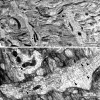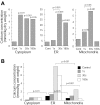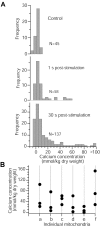Correlated calcium uptake and release by mitochondria and endoplasmic reticulum of CA3 hippocampal dendrites after afferent synaptic stimulation
- PMID: 12486158
- PMCID: PMC6758462
- DOI: 10.1523/JNEUROSCI.22-24-10653.2002
Correlated calcium uptake and release by mitochondria and endoplasmic reticulum of CA3 hippocampal dendrites after afferent synaptic stimulation
Abstract
Mitochondria and endoplasmic reticulum (ER) are important modulators of intracellular calcium signaling pathways, but the role of these organelles in shaping synaptic calcium transients in dendrites of pyramidal neurons remains speculative. We have measured directly the concentrations of total Ca (bound plus free) within intracellular compartments of proximal dendrites of CA3 hippocampal neurons at times after synaptic stimulation corresponding to the peak of the cytoplasmic free Ca2+ transient (1 sec), to just after its decay (30 sec), and to well after its return to prestimulus levels (180 sec). Electron probe microanalysis of cryosections from rapidly frozen slice cultures has revealed that afferent mossy fiber stimulation evokes large, rapid elevations in the concentration of total mitochondrial Ca ([Ca](mito)) in depolarized dendrites. A single tetanus (50 Hz/1 sec) elevated [Ca](mito) more than fivefold above characteristically low basal levels within 1 sec of stimulation and >10-fold by 30 sec after stimulation. This strong Ca accumulation was reversible, because [Ca](mito) had recovered by 180 sec after the tetanus. Ca sequestered within mitochondria was localized to small inclusions that were distributed heterogeneously within, and probably among, individual mitochondria. By 30 sec after stimulation an active subpopulation of ER cisterns had accumulated more Ca than had mitochondria despite a approximately 1 sec delay before the onset of accumulation. Active ER cisterns retained their Ca load much longer (>3 min) than mitochondria. The complementary time courses of mitochondrial versus ER Ca2+ uptake and release suggest that these organelles participate in a choreographed interplay, each shaping dendritic Ca2+ signals within characteristic regimes of cytosolic Ca2+ concentration and time.
Figures




Similar articles
-
Activity-dependent calcium sequestration in dendrites of hippocampal neurons in brain slices.J Neurosci. 1997 Nov 15;17(22):8729-38. doi: 10.1523/JNEUROSCI.17-22-08729.1997. J Neurosci. 1997. PMID: 9348342 Free PMC article.
-
Dendritic calcium transients evoked by single back-propagating action potentials in rat neocortical pyramidal neurons.J Physiol. 1995 May 15;485 ( Pt 1)(Pt 1):1-20. doi: 10.1113/jphysiol.1995.sp020708. J Physiol. 1995. PMID: 7658365 Free PMC article.
-
Depolarization-induced long-term depression at hippocampal mossy fiber-CA3 pyramidal neuron synapses.J Neurosci. 2003 Oct 29;23(30):9786-95. doi: 10.1523/JNEUROSCI.23-30-09786.2003. J Neurosci. 2003. PMID: 14586006 Free PMC article.
-
Microheterogeneity of calcium signalling in dendrites.J Physiol. 2000 May 15;525 Pt 1(Pt 1):53-61. doi: 10.1111/j.1469-7793.2000.t01-1-00053.x. J Physiol. 2000. PMID: 10811724 Free PMC article. Review.
-
Ca2+ signalling in postsynaptic dendrites and spines of mammalian neurons in brain slice.J Physiol Paris. 1992;86(1-3):57-66. doi: 10.1016/s0928-4257(05)80008-7. J Physiol Paris. 1992. PMID: 1343597 Review.
Cited by
-
Cyclophilin D regulates neuronal activity-induced filopodiagenesis by fine-tuning dendritic mitochondrial calcium dynamics.J Neurochem. 2018 Aug;146(4):403-415. doi: 10.1111/jnc.14484. Epub 2018 Aug 16. J Neurochem. 2018. PMID: 29900530 Free PMC article.
-
Mitochondria-associated membranes as hubs for neurodegeneration.Acta Neuropathol. 2016 Apr;131(4):505-23. doi: 10.1007/s00401-015-1528-7. Epub 2016 Jan 7. Acta Neuropathol. 2016. PMID: 26744348 Free PMC article. Review.
-
Interactions between mitochondria and the transcription factor myocyte enhancer factor 2 (MEF2) regulate neuronal structural and functional plasticity and metaplasticity.J Physiol. 2015 Aug 15;593(16):3471-81. doi: 10.1113/jphysiol.2014.282459. Epub 2015 Jan 29. J Physiol. 2015. PMID: 25581818 Free PMC article. Review.
-
Insight into the role of phosphatidylserine in complement-mediated synapse loss in Alzheimer's disease.Fac Rev. 2021 Feb 24;10:19. doi: 10.12703/r/10-19. eCollection 2021. Fac Rev. 2021. PMID: 33718936 Free PMC article. Review.
-
Optical and pharmacological tools to investigate the role of mitochondria during oxidative stress and neurodegeneration.Prog Neurobiol. 2006 Jun;79(3):136-71. doi: 10.1016/j.pneurobio.2006.07.001. Prog Neurobiol. 2006. PMID: 16920246 Free PMC article. Review.
References
Publication types
MeSH terms
Substances
LinkOut - more resources
Full Text Sources
Miscellaneous
